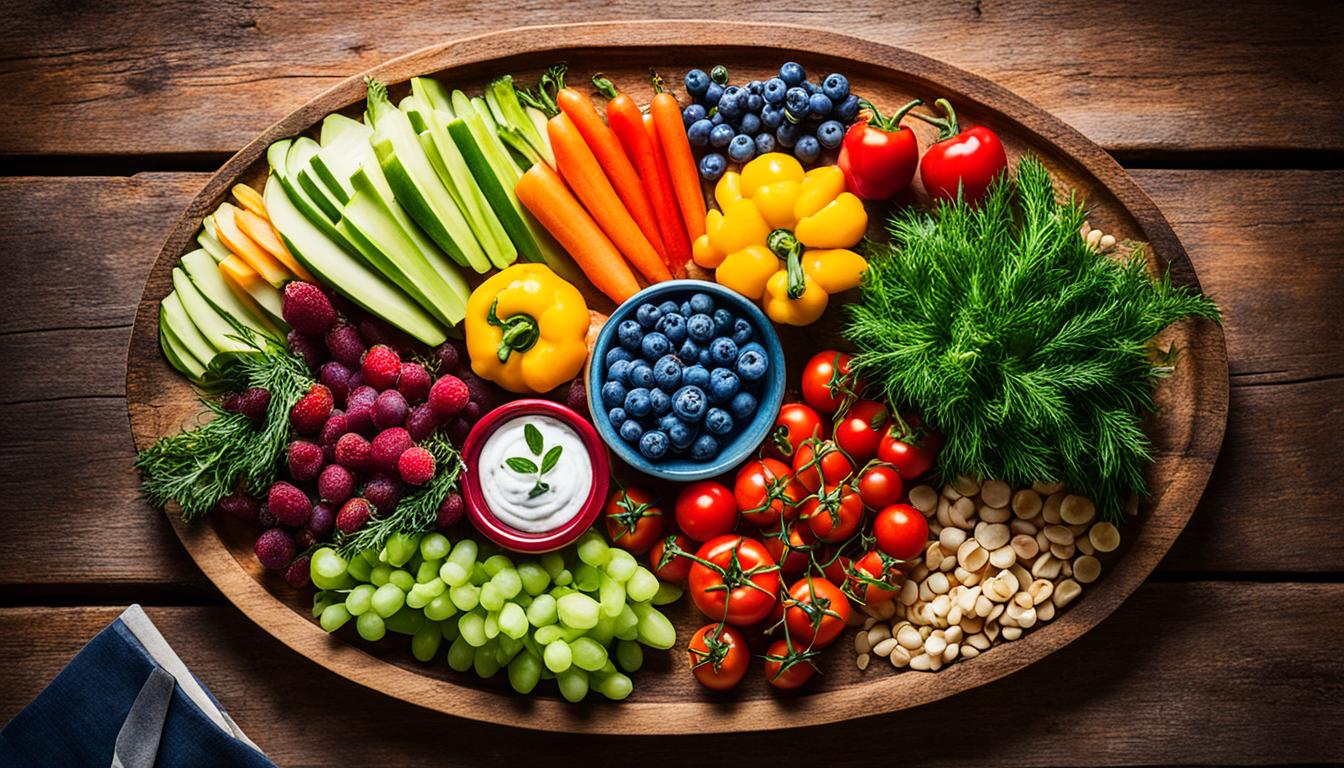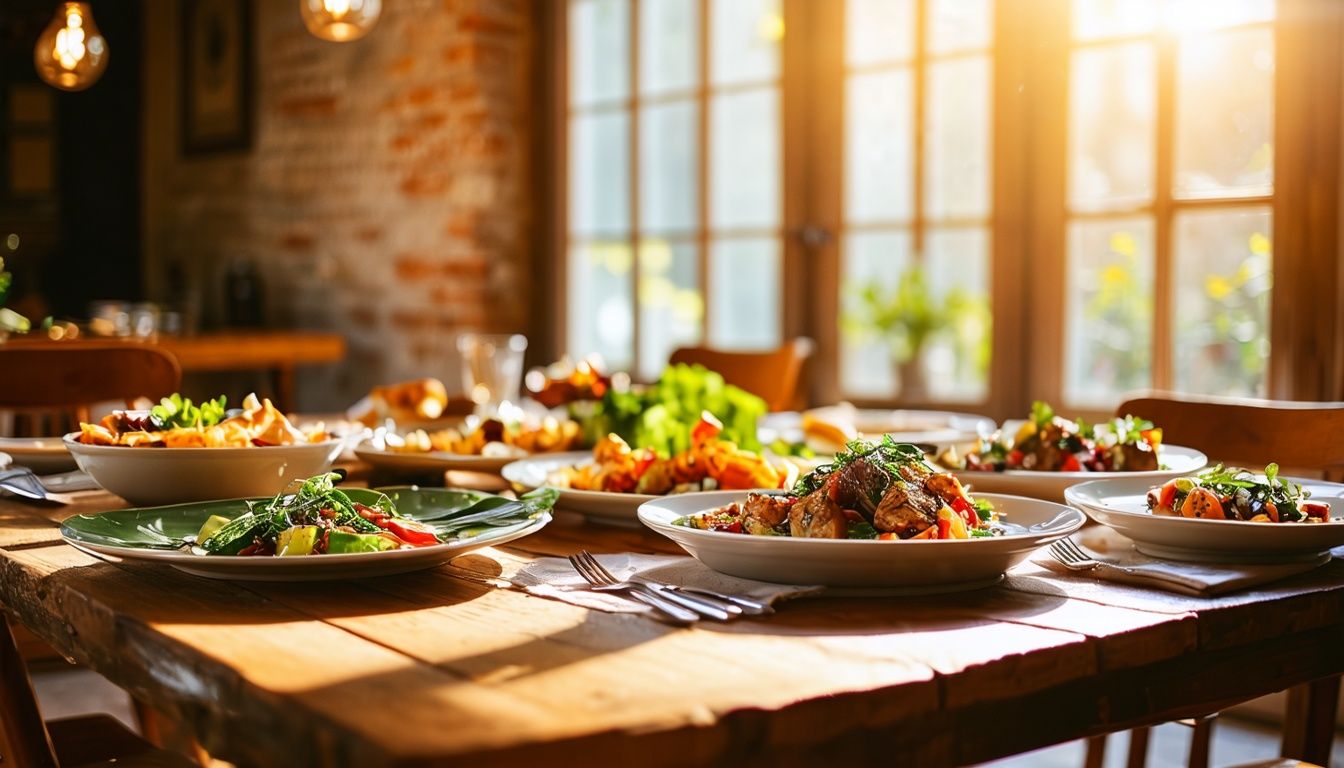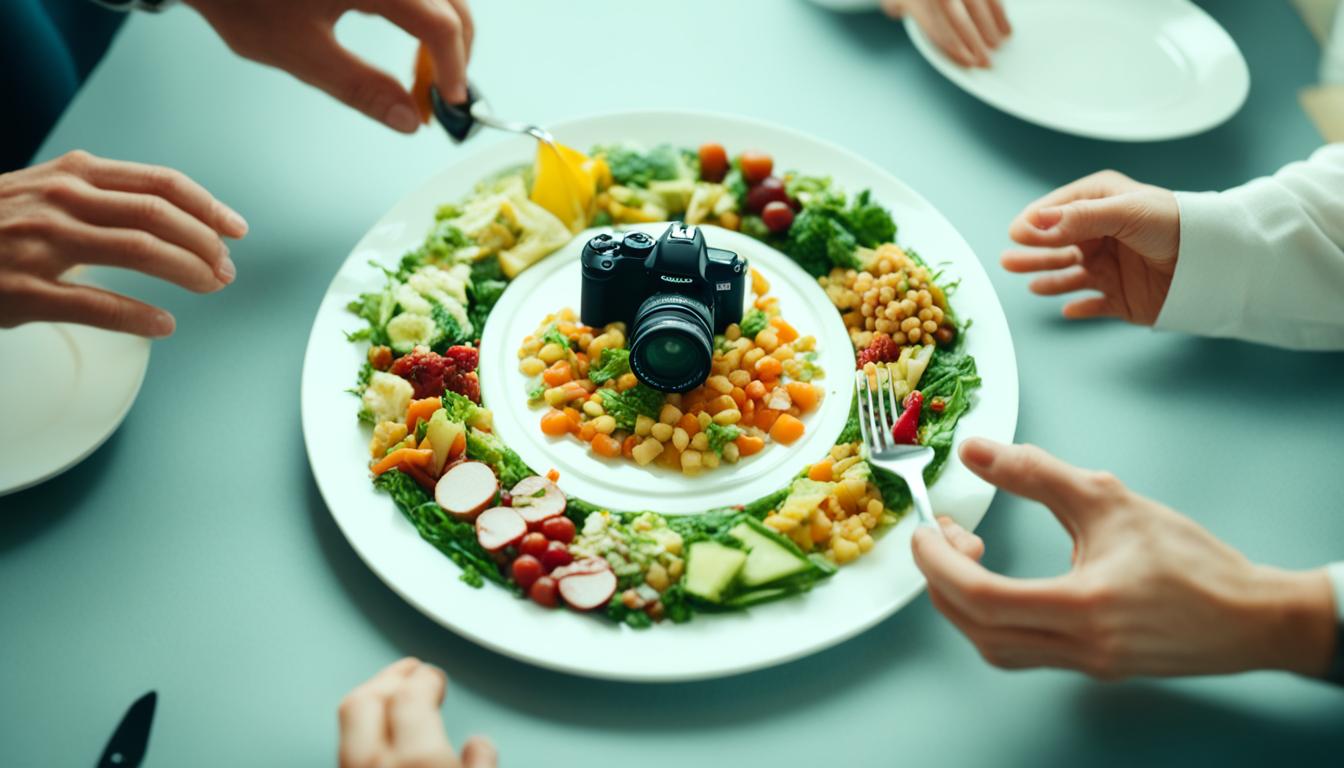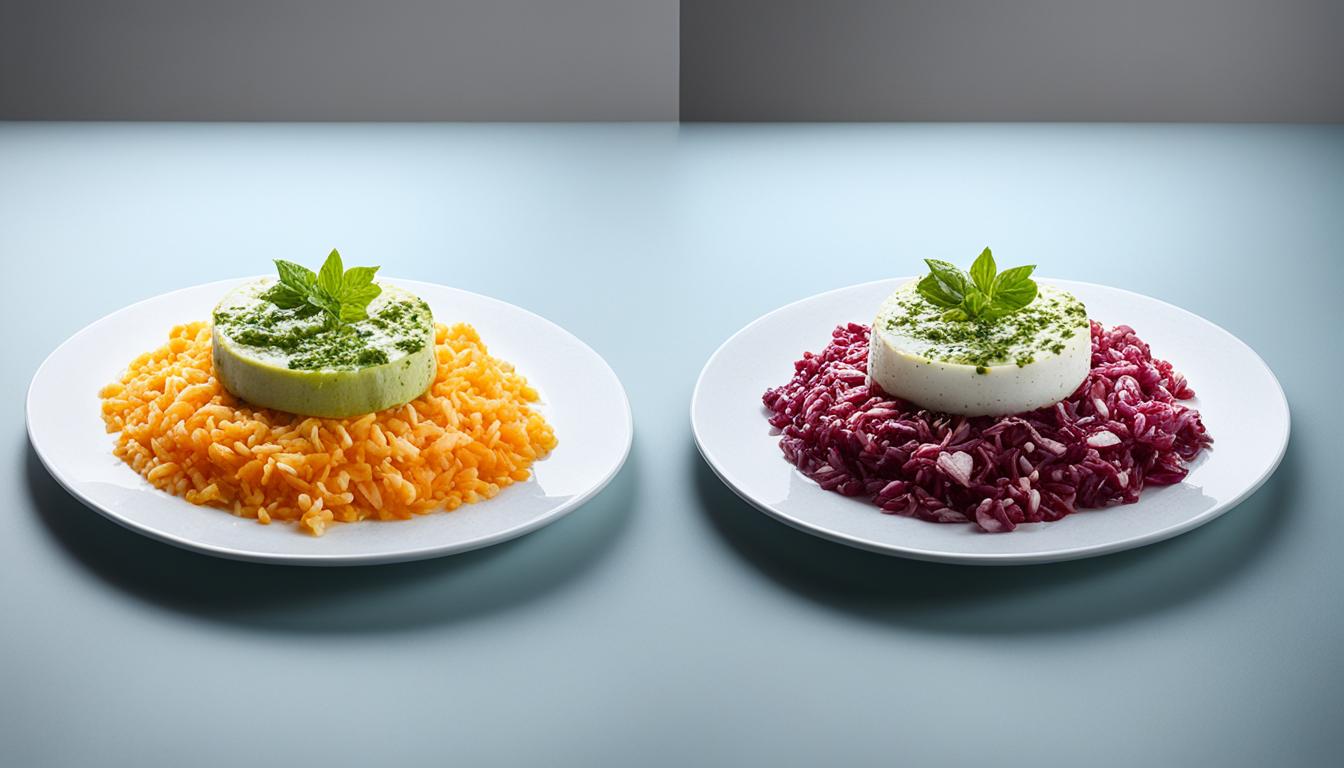Welcome to our exciting exploration of the world of food photography! In this article, we will dive into the captivating art of capturing culinary creations in vibrant visuals. From innovative techniques to emerging styles, we will uncover the latest trends that make food photography a feast for the eyes.
Key Takeaways:
- Food photography combines artistry and culinary delights to create visually appealing images.
- Current trends include still life compositions, isometric patterns, styled tables, hand in shots, color blocking, levitating effects, monochromatic compositions, minimalistic approaches, mouthwatering close-ups, and creative approaches.
- Photographers like Julia Guedes, Marina Cusso, Valentina Cesta, Aaron Cameron, Sasha Gerritzen, Rae Finn, Mary Devinat, Estudio Pilea, Barbora Bydzovska, Miriam Rapado, Miho Saji, Alisa Chirva, Jahnabi Basumatary, Catrine Haland, Joana Alves, Laura Baiardani, Gracjan Donarski, and Sosiura Olya have explored these trends and produced stunning food photography.
- By understanding and utilizing these techniques, photographers can create images that capture the essence of culinary creations and leave viewers hungry for more.
- Food photography trends continue to evolve, offering endless opportunities for creativity and innovation.
Still Life Composition
Still life compositions are timeless and captivating. This trend focuses on arranging food or food products in a visually appealing way. Photographers like Julia Guedes and Marina Cusso have mastered the art of creating stunning still life compositions that capture attention and showcase the beauty of culinary creations.
Julia Guedes
“I love creating still life compositions that bring out the vibrant colors and textures of food. It’s like painting with ingredients and creating visual stories for viewers to savor.”
Marina Cusso
“In still life photography, composition is key. Every element in the frame should have a purpose and contribute to the overall beauty and appeal of the image. It’s about creating eye-catching arrangements that make viewers want to taste the food itself.”
| Photographer | Specialty | Quote |
|---|---|---|
| Julia Guedes | Still Life Composition | “I love creating still life compositions that bring out the vibrant colors and textures of food. It’s like painting with ingredients and creating visual stories for viewers to savor.” |
| Marina Cusso | Still Life Composition | “In still life photography, composition is key. Every element in the frame should have a purpose and contribute to the overall beauty and appeal of the image. It’s about creating eye-catching arrangements that make viewers want to taste the food itself.” |
Isometric Patterns
Isometric patterns have become a popular trend in food photography, offering a unique and visually appealing touch to images. Whether you choose to create these patterns through Photoshop or manually arrange food items, they can be applied to various platforms such as banners and stories. This trend allows photographers to create captivating visuals that stand out from the crowd.
One photographer who has embraced isometric patterns is Valentina Cesta. She skillfully incorporates these patterns into her food photography, elevating the overall composition and adding a touch of creativity. Valentina’s work showcases the endless possibilities and beauty of isometric patterns.
Another renowned photographer who has explored this trend is Aaron Cameron. Through his meticulous attention to detail, Aaron creates stunning food photography that incorporates isometric patterns in a seamless and eye-catching way. His work has captivated the audience and inspired other photographers to experiment with this trend.
To exemplify the creative possibilities of isometric patterns in food photography, take a look at the following image:
“Incorporating isometric patterns into food photography brings a whole new dimension to the images. It adds depth, visual interest, and a unique perspective. The patterns can be arranged in such a way that they complement the shape and texture of the food, creating a harmonious composition.” – Valentina Cesta
Isometric patterns offer food photographers a versatile tool to elevate their work and create visually captivating images. Whether you choose to integrate them into your compositions through Photoshop or manual arrangement, isometric patterns can add a unique touch to your food photography.
Styled Tables
Styled tables have become a classic trend in food photography. Photographers are showcasing mouthwatering culinary creations on beautifully arranged tabletop settings, capturing the essence of relaxed and inviting dining experiences. In recent times, there has been a shift towards a more natural and casual look, reminiscent of taking pictures of food while waiting for a friend to join. This approach aims to create a genuine and inviting atmosphere in food photography, enhancing the natural beauty of the dishes.
Photographers like Sasha Gerritzen, Rae Finn, and Mary Devinat have embraced this trend, utilizing their creative vision to curate visually stunning tables that evoke a sense of warmth and authenticity. By incorporating elements such as rustic wooden surfaces, handcrafted ceramics, and carefully selected props, they create compositions that exude a natural charm.
These skilled photographers understand the importance of creating a balance between composition, lighting, and styling, ensuring that every element in the frame complements the main subject—the food. Their expertise in capturing the intricate details and textures of the dishes adds depth and dimension to the photographs, making them truly captivating.
To further illustrate this trend, we present a visual representation of a styled table concept created by Sasha Gerritzen:
| Styled Table Concept | Description |
|---|---|
 |
A beautifully styled table showcasing a delectable spread of vibrant dishes. The table is adorned with fresh flowers, carefully arranged cutlery, and rustic serving platters, creating an inviting and welcoming ambiance. |
As you can see, the attention to detail and the artistic arrangement of elements in the image create a compelling narrative, inviting viewers to imagine themselves indulging in the culinary delights on the table.
The styled tables trend harmonizes the art of food photography with the essence of a shared dining experience. By capturing the natural look and feel of a beautifully set table, photographers like Sasha Gerritzen, Rae Finn, and Mary Devinat transport viewers into a world where delicious food and conviviality converge.
Hand in Shots
Including hands in food photography adds a human element to the images, creating a sense of interaction and storytelling. This trend has made a comeback in social media feeds, capturing the attention of viewers. Photographers like Estudio Pilea and Barbora Bydzovska have effectively incorporated hands into their food photography, showcasing the connection between people and the food they enjoy.
When hands are featured in food photography, it adds a personal touch, allowing viewers to imagine themselves reaching out and indulging in the culinary delights. The hands bring a sense of reality and relatability to the image, evoking emotions and making the food more enticing.
Estudio Pilea, a renowned photography studio, has mastered the art of capturing hand in shots that tell a story. Whether it’s a delicate hand holding a cup of steaming coffee or a pair of hands diving into a bowl of pasta, the images speak volumes about the love and appreciation for food.
Another talented photographer, Barbora Bydzovska, embraces the human element in her food photography. Through her skilled composition and attention to detail, she creates images that not only showcase the deliciousness of the food but also the joy and satisfaction that comes with the dining experience.
Hand in shots allow us to feel a deeper connection to food and the people who prepare and enjoy it. These images remind us that food is not just about taste; it’s about the experience, the emotions, and the connections we share.
Hand in shots capture the essence of shared meals, family gatherings, and moments of pure pleasure. They transport us to a place where food is not just sustenance but a celebration of life and togetherness.
Color Blocking and Levitating Effects
Color blocking is a technique that creates visually striking food photography by using bold and contrasting colors as backgrounds. By eliminating distractions, color blocking directs the viewer’s attention to the food and makes it the focal point of the image. When executed skillfully, this technique produces captivating photos that leave a lasting impression.
To take color blocking to the next level, some photographers have also incorporated levitating effects into their images. This creative approach involves creating the illusion of food or food products floating in mid-air, adding an element of intrigue and imagination. These levitating effects further elevate the visual impact of the photographs, making them stand out from the rest.
“Color blocking and levitating effects allow us to push the boundaries of food photography. By using bold colors and introducing a sense of wonder with levitation, we create visually stunning images that captivate viewers and leave a lasting impression.” – Miriam Rapado
Renowned food photographers like Miriam Rapado, Miho Saji, and Alisa Chirva have successfully embraced and mastered these techniques, producing visually stunning food photography that is admired by audiences around the world. Their unique perspectives and creativity shine through their work, inspiring other photographers to explore the possibilities of color blocking and levitating effects in their own compositions.
Get ready to be mesmerized by some inspiring examples of color blocking and levitating effects in food photography:
| Photographer | Example Image |
|---|---|
| Miriam Rapado | |
| Miho Saji | |
| Alisa Chirva |
Monochromatic and Minimalistic Approaches
When it comes to food photography, the monochromatic and minimalistic approaches have gained significant popularity in recent years. These styles offer a fresh take on capturing culinary creations, elevating them to new levels of visual appeal. The use of a single color or shades of the same color creates a harmonious and cohesive look, allowing the food to take center stage.
The monochromatic trend enhances the beauty of the food by eliminating distractions and creating a visually pleasing composition. It allows the colors and textures of the dish to shine through, capturing the viewer’s attention and creating a visually striking image. Whether it’s a rich and deep shade of blue, a vibrant pop of red, or a soothing palette of earth tones, the monochromatic approach showcases the artistry in every dish.
Inspiring Monochromatic Food Photography
Let’s take a look at some talented photographers who have mastered the art of monochromatic food photography:
- Jahnabi Basumatary – Jahnabi’s monochromatic food photography captures the essence of each dish, emphasizing the exquisite details and textures. Her use of color creates a unique visual experience, making every image a work of art.
- Catrine Haland – Catrine’s minimalist approach in food photography showcases the elegance and simplicity of each dish. Her use of a single color palette highlights the beauty in minimalism and creates a serene visual aesthetic.
- Barbora Bydzovska – Barbora’s monochromatic food photography brings a sense of drama and intrigue to each dish. Her use of bold colors creates a visually captivating experience, making food the main protagonist in her images.
These talented photographers have proven that the monochromatic and minimalistic styles are not only visually striking but also capable of capturing the essence and beauty of culinary creations. Whether it’s a vibrant burst of color or a subtle and subdued palette, monochromatic and minimalistic approaches in food photography continue to inspire and captivate viewers.

Minimalistic Approaches: The Beauty of Simplicity
The minimalistic approach in food photography embraces the concept of “less is more.” By stripping away unnecessary elements, the focus is solely on the food itself. This approach highlights the textures, colors, and intricacies of the dish, resulting in a captivating visual experience.
“In minimalistic food photography, simplicity reigns supreme. Every element is carefully curated, allowing the dish to take center stage and speak for itself.” – Anonymous
Photographers who excel in minimalist food photography understand the power of simplicity. By using clean lines, negative space, and thoughtful compositions, they create images that evoke a sense of calmness and elegance. The minimalist approach allows the viewer to appreciate the artistry in each dish, making them yearn to taste the flavors and experience the textures.
For those inspired by a minimalist aesthetic, exploring the work of Jahnabi Basumatary, Catrine Haland, and Barbora Bydzovska is a must. These talented photographers have mastered the minimalistic approach, capturing the beauty of simplicity in every frame.
Mouthwatering Close-ups and Creative Approaches
Close-up shots of food are highly effective in enticing viewers and stirring their cravings. These high-quality close-ups capture the details and textures of the food, making it almost tangible. Whether it’s the glistening glaze on a perfectly cooked steak or the gooey cheese oozing out of a freshly baked pizza, close-up food photography brings the viewer up close and personal with the culinary delights.
Photographers like Joana Alves, Mary Devinat, Laura Baiardani, Gracjan Donarski, and Sosiura Olya have mastered the art of capturing mouthwatering close-ups that make you want to reach into the screen and take a bite. These talented photographers skillfully use lighting, composition, and focus to showcase every delicious detail, from the vibrant colors to the intricate textures.
But food photography isn’t just about the close-ups. Creative approaches to food photography allow photographers to step outside the box and experiment with different angles, compositions, and concepts. It’s about finding new and innovative ways to showcase culinary creations and tell a story through visuals.
Joana Alves, for example, takes a playful approach to her food photography, incorporating whimsical props and imaginative compositions to create visually captivating images. Mary Devinat, on the other hand, embraces simplicity and minimalism, letting the food speak for itself in clean and elegant compositions.
“Food photography is an endless sea of possibilities. It’s about pushing the boundaries, exploring new techniques, and constantly challenging yourself to create something unique and memorable.” – Joana Alves
By pushing the limits of creativity, photographers like Laura Baiardani, Gracjan Donarski, and Sosiura Olya have carved their own niche in the food photography world. Laura Baiardani creates stunning visual narratives, combining food with nature and storytelling elements. Gracjan Donarski experiments with unconventional angles and compositions, adding a fresh and unexpected perspective to his images. Sosiura Olya takes a conceptual approach, using symbolism and metaphors to evoke emotions and spark curiosity in viewers.
Through their innovative and artistic approaches, these photographers inspire and challenge fellow food photographers to think outside the box and push the boundaries of traditional food photography.
The Power of Visual Storytelling
One of the strengths of mouthwatering close-ups and creative approaches is their ability to tell a story. By carefully selecting props, backgrounds, and compositions, photographers can create images that transport viewers to a specific time, place, or emotion. Each photograph becomes a chapter in the visual story, inviting viewers to immerse themselves in the culinary world.
Whether it’s a close-up of steaming hot soup, capturing the comforting warmth on a cold winter day, or a creative composition of a picnic spread, evoking the carefree joy of summertime, each photograph has the power to elicit a unique emotional response.
Through their craft, Joana Alves, Mary Devinat, Laura Baiardani, Gracjan Donarski, and Sosiura Olya have mastered the art of visual storytelling, using their creative approaches to engage and captivate audiences.
Unleashing Your Creativity
If you’re an aspiring food photographer, take inspiration from these talented photographers and dare to unleash your creativity. Experiment with different angles, compositions, and concepts. Don’t be afraid to think outside the box and try something new.
“The key to creative food photography is to let your imagination run wild and challenge the norms. Dare to be different, and you’ll create images that leave a lasting impression.” – Mary Devinat
Remember, food photography is an art form that allows you to express your unique perspective and showcase your culinary passions. So go ahead, grab your camera, and let your creativity shine.
Conclusion
Food photography is an ever-evolving art that allows photographers to express their creativity and capture the beauty of culinary creations. The trends discussed in this article showcase the diversity and innovation in food photography styles. From still life compositions to isometric patterns, styled tables to hand in shots, color blocking to levitating effects, monochromatic styles to minimalistic approaches, mouthwatering close-ups to creative ideas, there are endless possibilities to explore.
Photographers can choose to follow these trends or develop their own unique style. The goal remains the same: to capture the essence and visual appeal of food in a way that leaves viewers hungry for more. Whether it’s capturing vibrant visuals of a well-styled table or focusing on the minute details in a mouthwatering close-up, photographers have the opportunity to create stunning and impactful food photography that stands out.
As trends continue to evolve, it’s essential for photographers to stay up-to-date and experiment with new techniques. By incorporating these trends and creative ideas into their work, photographers can showcase their skills and captivate their audience. Food photography is not only about capturing delicious dishes, but it’s also about telling a story, evoking emotions, and inspiring others to appreciate the artistry of food.
So, whether you’re a professional photographer or an aspiring enthusiast, don’t be afraid to explore different trends and styles. Embrace your creativity, experiment with innovative techniques, and let your passion for food photography shine through. With each click of the shutter, you have the opportunity to capture not just a meal, but a unique experience that will delight and inspire viewers around the world.
FAQ
What is food photography?
Food photography is the art of capturing visually appealing and drool-worthy photographs of culinary creations, focusing on colors, texture, and composition to make the images irresistible to viewers.
What are some popular food photography trends?
Some popular food photography trends include still life compositions, isometric patterns, styled tables, hand in shots, color blocking, levitating effects, monochromatic compositions, minimalistic approaches, mouthwatering close-ups, and creative approaches to food photography.
Who are some notable photographers known for still life composition?
Julia Guedes and Marina Cusso are notable photographers who have mastered the art of creating stunning still life compositions in food photography.
How can isometric patterns be incorporated into food photography?
Isometric patterns can be achieved through Photoshop or by manually arranging food items. Photographers like Valentina Cesta and Aaron Cameron have explored this trend and showcased its creative possibilities.
What is the concept of styled tables in food photography?
Styled tables involve arranging food products on beautifully set tabletop settings. The trend has recently shifted towards a more natural and casual look. Sasha Gerritzen, Rae Finn, and Mary Devinat have embraced this trend and captured the essence of relaxed and inviting dining experiences.
How do hand in shots add a human element to food photography?
Including hands in food photography adds a sense of interaction and storytelling, creating a connection between people and the food they enjoy. Estudio Pilea and Barbora Bydzovska are photographers who effectively incorporate hands into their food photography.
What is the technique of color blocking in food photography?
Color blocking involves using bold and contrasting colors as backgrounds to direct the viewer’s attention to the food. It eliminates distractions and makes the food the focal point of the image.
What are levitating effects in food photography?
Levitating effects involve creating the illusion of food or food products floating in mid-air, adding a touch of creativity and intrigue to the photographs. Miriam Rapado, Miho Saji, and Alisa Chirva are photographers who have embraced these techniques in their food photography.
What are monochromatic and minimalistic approaches in food photography?
Monochromatic compositions focus on using a single color or shades of the same color to create visually harmonious images, while minimalistic approaches rely on simplicity and “less is more” concept. Jahnabi Basumatary, Catrine Haland, and Barbora Bydzovska are photographers known for mastering these styles in food photography.
How do mouthwatering close-ups and creative approaches enhance food photography?
Mouthwatering close-ups capture the details and textures of the food, making it almost tangible. Creative approaches allow photographers to experiment with different angles, compositions, and concepts to create unique and captivating images. Joana Alves, Mary Devinat, Laura Baiardani, Gracjan Donarski, and Sosiura Olya are photographers who have explored these techniques.
Why are food photography trends important?
Food photography trends offer photographers endless opportunities for creativity and innovation. Following or developing these trends can help photographers capture the essence and visual appeal of culinary creations, leaving viewers hungry for more.
What Are the Latest Trends in Food Photography and How Can I Apply Them to Advanced Techniques?
The latest trends in food photography involve incorporating advanced food photography techniques such as focus stacking, dynamic lighting, and creative compositions. By mastering these techniques, photographers can elevate their food images to a professional level, creating visually stunning and impactful photos that stand out in the competitive world of food photography.




